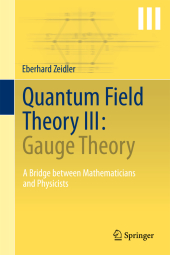 Neuerscheinungen 2011Stand: 2020-01-07 |
Schnellsuche
ISBN/Stichwort/Autor
|
Herderstraße 10
10625 Berlin
Tel.: 030 315 714 16
Fax 030 315 714 14
info@buchspektrum.de |

Eberhard Zeidler
Quantum Field Theory III: Gauge Theory
A Bridge between Mathematicians and Physicists
2011. xxxii, 1126 S. 15 Tabellen. 235 mm
Verlag/Jahr: SPRINGER, BERLIN 2011
ISBN: 3-642-22420-2 (3642224202)
Neue ISBN: 978-3-642-22420-1 (9783642224201)
Preis und Lieferzeit: Bitte klicken
In this third volume of his modern introduction to quantum field theory, Eberhard Zeidler examines the mathematical and physical aspects of gauge theory as a principle tool for describing the four fundamental forces which act in the universe: gravitative, electromagnetic, weak interaction and strong interaction.
Volume III concentrates on the classical aspects of gauge theory, describing the four fundamental forces by the curvature of appropriate fiber bundles. This must be supplemented by the crucial, but elusive quantization procedure.
The book is arranged in four sections, devoted to realizing the universal principle force equals curvature:
Part I: The Euclidean Manifold as a Paradigm
Part II: Ariadneīs Thread in Gauge Theory
Part III: Einsteinīs Theory of Special Relativity
Part IV: Ariadneīs Thread in Cohomology
For students of mathematics the book is designed to demonstrate that detailed knowledge of the physical background helps to reveal interesting interrelationships among diverse mathematical topics. Physics students will be exposed to a fairly advanced mathematics, beyond the level covered in the typical physics curriculum.
Quantum Field Theory builds a bridge between mathematicians and physicists, based on challenging questions about the fundamental forces in the universe (macrocosmos), and in the world of elementary particles (microcosmos).
Prologue.- Part I. The Euclidean Manifold as a Paradigm: 1. The Euclidean Space E3 (Hilbert Space and Lie Algebra Structure).- 2. Algebras and Duality (Tensor Algebra, Grassmann Algebra, Cli_ord Algebra, Lie Algebra).- 3. Representations of Symmetries in Mathematics and Physics.- 4. The Euclidean Manifold E3.- 5. The Lie Group U(1) as a Paradigm in Harmonic Analysis and Geometry.- 6. Infinitesimal Rotations and Constraints in Physics.- 7. Rotations, Quaternions, the Universal Covering Group, and the Electron Spin.- 8. Changing Observers - A Glance at Invariant Theory Based on the Principle of the Correct Index Picture.- 9. Applications of Invariant Theory to the Rotation Group.- 10. Temperature Fields on the Euclidean Manifold E3.- 11. Velocity Vector Fields on the Euclidean Manifold E3.- 12. Covector Fields and Cartanīs Exterior Differential - the Beauty of Differential Forms.- Part II. Ariadneīs Thread in Gauge Theory: 13. The Commutative Weyl U(1)-Gauge Theory and the Electromagnetic Field.- 14. Symmetry Breaking.- 15. The Noncommutative Yang{Mills SU(N)-Gauge Theory.- 16. Cocycles and Observers.- 17. The Axiomatic Geometric Approach to Bundles.- Part III. Einsteinīs Theory of Special Relativity: 18. Inertial Systems and Einsteinīs Principle of Special Relativity.- 19. The Relativistic Invariance of the Maxwell Equations.- 20. The Relativistic Invariance of the Dirac Equation and the Electron Spin.- Part IV. Ariadneīs Thread in Cohomology: 21. The Language of Exact Sequences.- 22. Electrical Circuits as a Paradigm in Homology and Cohomology.- 23. The Electromagnetic Field and the de Rham Cohomology.- Appendix.- Epilogue.- References.- List of Symbols.- Index
The author is a retired director of the Max Planck Institute for Mathematics in the Sciences, Leipzig (Germany). He is a member of the German National Academy of Sciences, Leopoldina.


